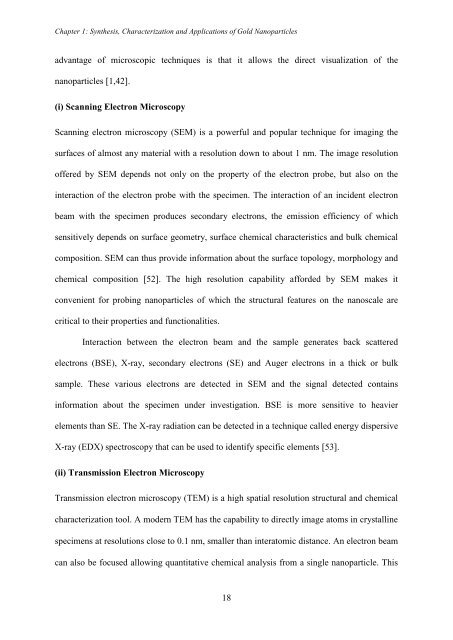PHYS01200704032 Debes Ray - Homi Bhabha National Institute
PHYS01200704032 Debes Ray - Homi Bhabha National Institute
PHYS01200704032 Debes Ray - Homi Bhabha National Institute
You also want an ePaper? Increase the reach of your titles
YUMPU automatically turns print PDFs into web optimized ePapers that Google loves.
Chapter 1: Synthesis, Characterization and Applications of Gold Nanoparticles<br />
advantage of microscopic techniques is that it allows the direct visualization of the<br />
nanoparticles [1,42].<br />
(i) Scanning Electron Microscopy<br />
Scanning electron microscopy (SEM) is a powerful and popular technique for imaging the<br />
surfaces of almost any material with a resolution down to about 1 nm. The image resolution<br />
offered by SEM depends not only on the property of the electron probe, but also on the<br />
interaction of the electron probe with the specimen. The interaction of an incident electron<br />
beam with the specimen produces secondary electrons, the emission efficiency of which<br />
sensitively depends on surface geometry, surface chemical characteristics and bulk chemical<br />
composition. SEM can thus provide information about the surface topology, morphology and<br />
chemical composition [52]. The high resolution capability afforded by SEM makes it<br />
convenient for probing nanoparticles of which the structural features on the nanoscale are<br />
critical to their properties and functionalities.<br />
Interaction between the electron beam and the sample generates back scattered<br />
electrons (BSE), X-ray, secondary electrons (SE) and Auger electrons in a thick or bulk<br />
sample. These various electrons are detected in SEM and the signal detected contains<br />
information about the specimen under investigation. BSE is more sensitive to heavier<br />
elements than SE. The X-ray radiation can be detected in a technique called energy dispersive<br />
X-ray (EDX) spectroscopy that can be used to identify specific elements [53].<br />
(ii) Transmission Electron Microscopy<br />
Transmission electron microscopy (TEM) is a high spatial resolution structural and chemical<br />
characterization tool. A modern TEM has the capability to directly image atoms in crystalline<br />
specimens at resolutions close to 0.1 nm, smaller than interatomic distance. An electron beam<br />
can also be focused allowing quantitative chemical analysis from a single nanoparticle. This<br />
18

















